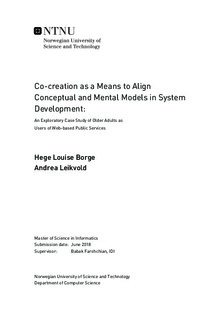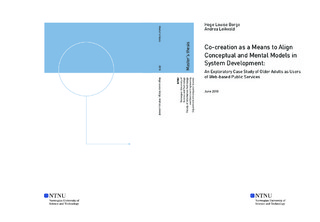| dc.description.abstract | In 2014, the Norwegian government introduced the strategy "Digital by Default" (Norwegian: "digitalt førstevalg"), which means all correspondence with the public sector should become digital. However, the web services introduced by the public sector turned out to be difficult to use, especially to some groups in society. Older adults are a group of people that are easily left behind. The aim of this research was to understand how early and direct involvement of users is practiced today, and how a lack of user involvement can affect the cost of digitalizing public services. Another goal was to examine older adults' experiences in use of public digital services, and their support network.
An exploratory case study was conducted by observing older adults in their use of digital services and interviewing representatives from the target group. In addition, interviews with relevant stakeholders were held. These include SeniorNet Trondheim, the Learning center at Trondheim public library, the Ministry of Local Government and Modernization and developers and designers of the public services. A co-design workshop with the target group was also conducted. This resulted in a prototype of a new design of digipost.no, followed by a usability test and evaluation to compare the designs.
The findings from this research show that older adults have physical limitations making it challenging to use the web-based public services, and that they are dependent on support. Specific recommendations when designing for older adults were identified. In current practice, users are involved in the development process through usability testing to verify the usability of the solutions. When involving users directly in the design process, this study shows that new solutions can be discovered. These solutions are closer to the users' mental models and will provide more intuitive systems. This entails less cost related to the introduction of new digitalized services. In order to utilize the direct involvement of users it is important to have good tools to make the contributions evident. The theory of conceptual models and mental models indicated in this study to be a proper tool for the task. By investing time and money to create intuitive systems from the beginning, this will increase economical gain in the end. This requires less resources for further development of the design, teaching and follow-up services and provided support for the users that are left behind. It will also increase the sense of achievement and independence. Early and direct involvement can provide large economical savings for society, and simultaneously improve the situation for individual citizens. | |

